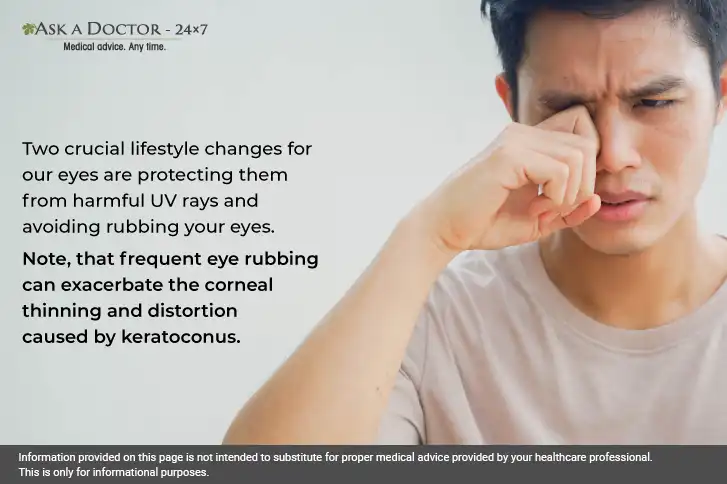What You Should Know About Keratoconus
Keratoconus (ker-uh-toe-KOH-nus) is an eye condition in which your cornea, the transparent, dome-shaped front of your eye, gradually thins and swells outward into a cone shape. The cornea, which focuses 65–75% of the pictures we view, is an important component of our eyes' refractive process. The images we see would become hazy if the corneas didn't undergo this refractive process. However, in keratoconus, a cone-shaped cornea not only causes blurred vision but may also cause sensitivity to light and glare. Keratoconus cannot be prevented, but early detection and treatment can halt the progression of the disease. Let’s understand keratoconcus in detail.
What Effects Does Keratoconus Have on Vision?
There are two ways that keratoconus alters vision:
- The cornea's smooth surface warps as it takes on a cone-like form. This condition is also known as irregular astigmatism or uneven astigmatism. Unfortunately, this change in the shape of the cornea keeps increasing your vision numbers and cannot be completely corrected with glasses.
- Your eye grows more short-sighted when the cornea's front steepens. You might therefore require new glasses more frequently.
Causes and Risk Factors of Keratoconus
The exact cause of keratoconus is unknown, but some factors can increase your risk of developing it, like:
- Genetic disorders: The risk of acquiring keratoconus is increased if you have a family history of the condition or have certain systemic disorders, like Down syndrome.
- Young age: Keratoconus typically first appears in teenagers between the ages of 16 and 30, being young increases the risk of developing the ailment.
- Eye inflammation: Frequent eye inflammation due to allergies can harm corneal tissue and might increase the incidence of keratoconus.
- Rubbing the eyes: Frequent rubbing of the eyes damages the cornea and increases the chance of developing keratoconus.
Symptoms of Keratoconus
The symptoms of keratoconus include:
- Blurry vision: In keratoconus, the cornea's refractive properties get impacted by the transition from a dome to a cone, and cause blurred vision.
- Double vision: Due to the cornea's abnormal shape and capacity to correctly refract light, double vision is also observed in keratoconus patients.
- Regular changes to vision eyeglass prescriptions: One of the most prevalent signs of keratoconus is the cornea's shifting shape, which leads to frequent increases in the number of vision glasses.
- Light sensitivity: The cornea is malformed, impairing its ability to refract light, causing sensitivity to light.
- 'Halo' surrounding lights: The changing shape of the cornea affects the process of how the light is received by the eye, and causes the 'halos' shape surrounding light's vision in a patient
Treatment of Keratoconus

The specific course of treatment for keratoconus will vary depending on the patient and the severity of the condition. The following is a list of keratoconus therapies:
- Glasses: Astigmatism, myopia, and hyperopia are among the vision problems that can be helped by wearing glasses. Given that keratoconus frequently impairs vision and causes problems like blurriness, keratoconus-related visual issues can be improved with the use of glasses.
- Contact lenses: Keratoconus can be treated with powered contact lenses or hard contact lenses, which assist in maintaining the cornea's ideal shape.
- Corneal cross-linking: Corneal crosslinking involves applying vitamin B12 eye drops to the eye and then utilizing UV light to strengthen the cornea. If keratoconus worsens, corneal cross-linking may be utilized to treat advanced cases. Although there are no cures for the condition, collagen cross-linking can stop its progression, protect vision, and postpone or avoid the corneal transplant.
- Corneal transplant: In a corneal transplant, the injured corneal portion gets replaced with a donor cornea.
So far, we have learned that keratoconus is characterized by a thinning of the cornea, thus changing to the cone-shaped cornea instead of the usual round, dome-shaped. This can cause vision issues such as blurriness. Early stages can be treated with glasses and contact lenses that help the light refract properly within the eye and treat blurry vision, while corneal transplantation may be needed to restore sight. If you think you're developing a vision issue such as keratoconus, then consult an ophthalmologist, immediately. An eye care professional or an optometrist will be able to conduct an eye test to assess vision and examine the cornea, to assess whether you have keratoconus.
If you have any questions related to the keratoconus, you can Ask an Ophthalmologist at Ask a Doctor - 24x7.
Recently Answered Questions Related to Keratoconus
- How Is Keratoconus Condition Affected In Pregnancy?
- What Is C3 R Treatment?
- Have Keratoconus, Undergone C3R Procedure, And Suggested To Wear Spectacles. Have Irritation And Redness With Lenses
- Suggest Treatment For Eye Pain And Distorted Vision While Having Keratoconus
- Pregnant, Having Keratoconus Problem In Eyes And Took C3R And ICL. Suggest?
- What Does Differential Diagnosis Mean Concerning Keratoconus? Could I Ask A Keratoconus Specialist?
Disclaimer: Information provided on this page is not intended to substitute for proper medical advice provided by your healthcare professional. This is only for informational purposes.
Ask a Specialist
Recent Questions


